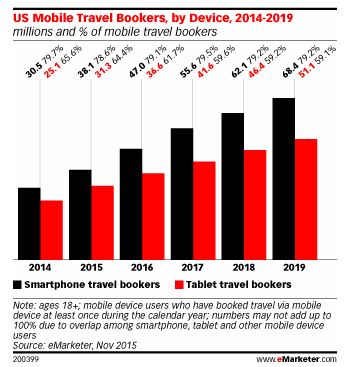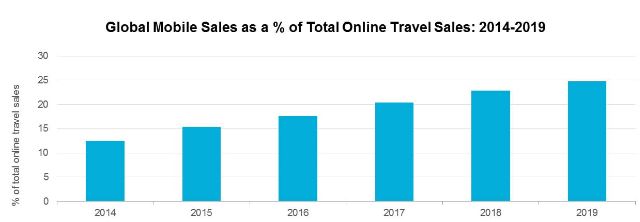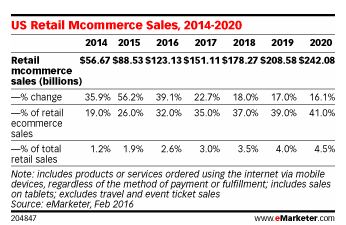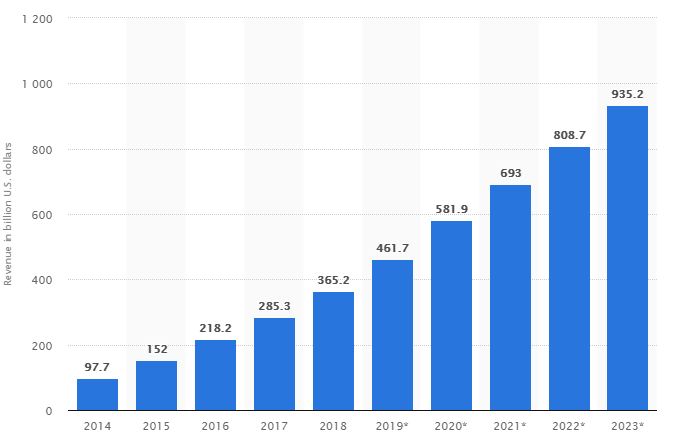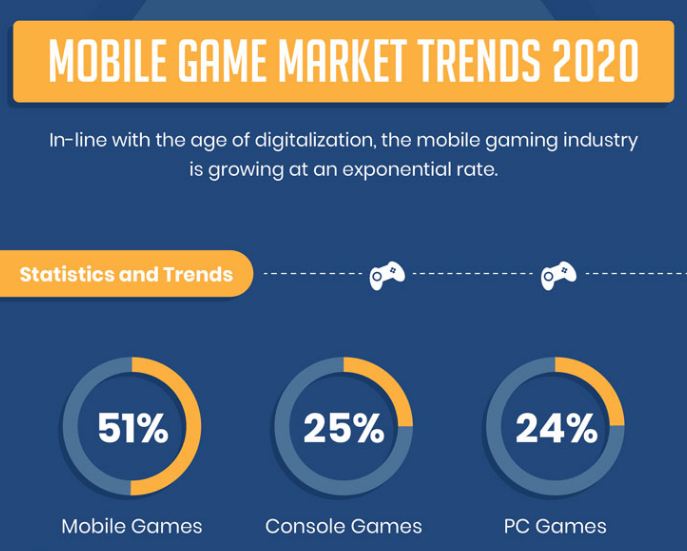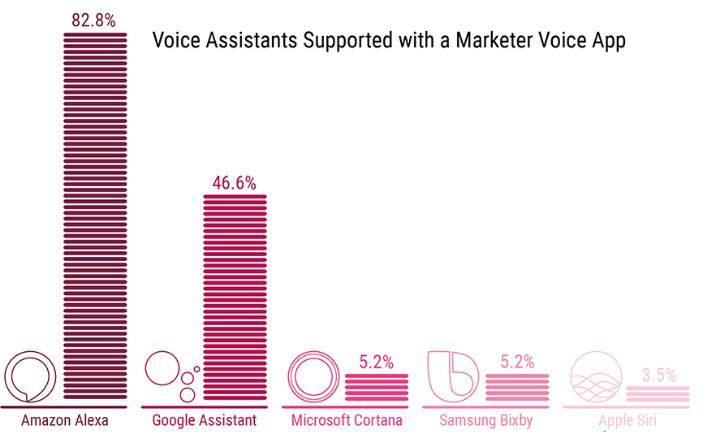We can also expect the number of mobile app downloads to increase in 2020 since Statista reveals that the number of mobile app downloads worldwide has increased in the past there years. We expect this trend to continue in both 2019 and 2020. Following is a graph showing the increase in mobile app downloads in the last there years:
Another interesting revelation made by AppsFlyer predicts that the global app install spends will reach $64.1 billion in 2020 from $38.9 billion in 2018, an increase of 65%. Following is a graph illustrating this:
(Above is a graph showing the global app install ad spends (in billions) for the period 2017-2020 [Image Source])
AppsFlyer also reveals that the region with the highest app install spends will be North America. The app install spend in the region is expected to grow to $12.9 billion by 2020.
(Above is an Infographic showing the app install ad spends (in billions) in North America for the period 2017-2020 [Image Source])
As per AppsFlyer’s findings, the growth in both the global and North American app install ad spends is mainly being driven by the increasing popularity of shopping apps, which make up almost 44% of all non-organic installs. However, gaming apps are also a major contributor to this growth with these apps, making up more than 40% of all non-organic installs.
The growth in app install ad spends has been possible due to the emergence of powerful hardware devices that support immersive, advanced gaming and shopping environments online. Another reason for this growth is the rising popularity of mobile apps to make purchases. According to research firm eMarketer Inc., the share of mobile in the overall U.S. online sales will reach almost
50% by 2020.
(Above is a graph showing U.S. smartphone retail Mcommerce sales for the period 2018-2022 [Image Source])
eMarketer also predicts smartphone retail Mcommerce sales to increase in the U.S. in 2020. Following is a graph showing this:
Forrester also predicts mobile to have a greater impact on U.S. online sales in 2020 and beyond. According to the market research company, more than
40% of all online sales in the U. S in 2022 will have at least some involvement of mobile. At 34% involvement, mobile contributes $1 trillion to the U.S. economy. This implies that its contribution to U.S. online sales and the country’s economy will be huge in 2022.
While considering the influence of mobile on online sales, it will be useful for companies—especially those that conduct most of their business online—to invest in a top-notch mobile application developed by a mobile app development company. The application will not only serve people who want to buy from a business, but it will help those who want to get more information about the business and its products/services.
Mobile Usage in 2020 and Beyond
Today, mobile and smartphones are an integral part of our lives. This is the reason the number of mobile users, smartphone devices, and app downloads is increasing each day. The following are some predictions related to mobile usage for 2020 and beyond that prove the growing popularity of both mobile phones and mobile applications.
Perhaps, the most important statistic related to mobile usage in the future is that the number of mobile users will reach 6.95 billion by 2021. Following is an illustration of this:
(Above is a graph showing the number of mobile users worldwide during the forecast period 2019-2023 [Image Source])
According to App Annie, the number of app downloads will exceed 250 billion by 2022. That is an increase of 45% from 2017. Following is an infographic depicting this:
(Above is an infographic showing global app downloads in years 2017, 2018, and 2022 [Image Source])
Looking at the above infographic, we can say with confidence that app downloads will increase worldwide in 2020.
App Annie also predicts the worldwide consumer spend at app stores to increase in 2020 and beyond. This is depicted in the following graph that shows the worldwide consumer spend in app stores in the years 2017, 2018, and 2022.
(Above is an infographic showing worldwide consumer spend in iOS App store, Google Play, and Third-Party Android stores combined in the years 2017, 2018, and 2022 [Image Source])
Another important statistic related to mobile applications by App Annie is that China, India, the U.S., Brazil, and Russia will be the five countries that will dominate the global app economy till 2022, at least. Following is an illustration of this:
(Above is an infographic showing top countries by app downloads (in billions) in 2017 and 2022 [Image Source])
The above infographic ranks countries by the number of app downloads in Google Play, iOS App Store, and third-party Android combined. App Annie also ranks countries by app spend in billions. Following is an infographic showing this:
(Above is an infographic showing top countries by spend in 2017 and 2022 [Image Source])
From the above statistics from App Annie, we find that China will dominate the global app economy in terms of the number of apps downloaded worldwide. India is expected to take second place. However, it will be some steps behind China, with the country recording 37.2 billion downloads compared to China’s 119.5 billion.
In terms of app spend, China is once again expected to lead the global app economy with a total of $62.4 in application spend. The U.S. is expected to come in second place. However, just like India, it will also be behind China. The list of top 5 countries in 2022 with the most app spend will be complete by Japan, South Korea, and Germany.
Digital media is another area where the development and usage of mobile applications are growing. In 2017, these applications accounted for
57% of all digital media usage, and the number was expected to increase in the following years.
For the top app development companies, the most interesting piece of information would be that, compared to the rest of the mobile users, people aged 16-24 spend 20% more time on apps that they frequently use. This should give the app developers an idea of which segment of the mobile users they need to target.
Apps Stats by Industry
According to Business Insider, the top three apps among millennials are Facebook, Gmail, and
Amazon, with the latter taking the pole position. Amazon’s app is popular because of the convenience of shopping that it offers.
To better understand the app trends for 2020 and beyond, it is important to look at how mobile applications are faring in different industries. The industries that we will look at are Banking and Fintech, Food and Restaurants, Travel and Transportation, and Retail and Shopping.
Networking and Communication
According to the Manifest, of all smartphone users, 39% use social media apps, 10% use gaming apps, and 10% use communication/messaging apps. Following is an illustration of this:
(Above is an graph showing the most frequently used mobile apps today [Image Source])
Another interesting statistic related to networking and communication comes from MindSea that says that social networking apps are the most commonly used app by millennials, with messaging apps taking second place. Following is an infographic depicting this:
(Above is an infographic showing the type of apps millennials use the most [Image Source])
From the above infographic, we find that the majority of millennial users today prefer communication and messaging apps over other types of apps. This trend is likely to continue in 2020 and the next few years after that.
Banking and Fintech
According to
App Annie, there were 3.4 billion app downloads related to banking and Fintech in 2018. This was an increase of more than 70% in just two years.
Another interesting statistic related to banking and Fintech is that the average time spent on banking and Fintech apps is 3.1 minutes. This is a good enough time for any banking institution or Fintech company to leave a lasting impression on their customers. Following is an illustration of this:
(Above is a graph showing the average time spent by users on the apps of different industries/sectors [Image Source])
Food and Restaurants
In 2018, the in-app food and drink orders increased by
130 percent from two years ago. Additionally, food delivery apps experienced a growth of 175 percent in the U.S. and 255 percent in Canada.
Travel and Transportation
Travel and Transportation is another area where the development, download, and use of mobile apps is likely to grow in 2020 and beyond.
According to App Annie, the top five ridesharing apps all experience a growth of
25% in 2018. LeanPlum reveals that the average time spent by users on travel apps is
2.8 minutes. Another interesting statistic by App Annie related to travel and transportation is that bike and scooter-sharing apps grew by more than
500 percent in 2018.
eMarketer reveals that half of all online bookings in the U.S. in 2016 occurred via mobile devices and apps. As predicted, this number has likely increased in the past three years, and the trend is expected to continue in 2020 and beyond. Following is an illustration of this finding:
(Above is a graph showing the percentage of U.S. mobile travel bookers by device during the period 2014-2019 [Image Source])
Another interesting app statistic related to travel and transportation is that a quarter of all online travel bookings in 2019 were expected to come through mobile devices. Following is a graph showing this:
(Above is an infographic showing the global mobile sales as a percentage of online travel sales during 2014-2019 [Image Source])
Retail and Shopping
One of the sectors witnessing rapid growth in the development and usage of mobile applications is retail. According to
eMarketer, the retail Mcommerce sales in the U.S. are expected to grow over $240 billion by 2020. Following is a table depicting this:
(Above is a table showing U.S. retail Mcommerce sales during 2014-2020 [Image Source])
According to LeanPlum, the average time spent by users on shopping and retail apps is
4.6 to 5 minutes.
App Annie reveals that shopping via mobile phones has increased by 70 percent in the past two years. The last bit of app statistic related to retail and shopping comes from Deloitte, which reveals that
50 percent of the time spent on retail sales is through mobile devices.
The purpose of the above app statistics related to networking and communication, banking and fintech, food and restaurants, travel and transportation, and retail and shopping, is to give readers an idea of how the development, download, and use of mobile applications is likely to grow in these industries/sectors in 2020 and beyond. However, we will not leave everything to the imagination. Instead, we will list right here some of the major predictions for mobile in 2020 and beyond.
Major predictions for 2020 and Beyond
According to
Statista, paid downloads and in-app advertising will contribute more than $500 billion to the global mobile app revenue in 2020. Following is a graph depicting this:
(Above is a graph showing worldwide mobile app revenues (in billions) during 2014-2023 [Image Source])
Another interesting revelation by Statista is that there will be about
179 million people in the U.S. in 2020 that will be watching video content on their mobile devices. Many of these people will be users of Facebook and YouTube apps.
(Above is an infographic showing the breakdown of the global gaming market share in 2020 [Image Source])
In addition to the above, App Annie predicts the global mobile gaming market to grow to
$165 billion in 2020. Another interesting statistic is that more than
30% of marketers will be using a voice app in 2020. Following is a graph showing the percentage of marketers using different voice apps in 2019. We don’t expect too much to change here in 2020.
(Above is a graph showing the number of marketers that support the different types of voice assistants with a marketer voice app. [Image Source])
Finally, IBM predicts the global workforce to grow to
1.87 billion workers by 2022, making up more than 40% of the global workforce. As a result, the development and use of mobile applications will increase to enable employees to be productive from virtually anywhere.
Mobile App Development Trends in 2020 to Watch Out For
As of February 2019, over
80% of Americans own a smartphone. Smartphone sales and usage is also increasing in many other countries, including highly populated ones like China and India. Since there will be billions of smartphone owners in 2020, it only makes sense for businesses to invest in mobile application development and work with a mobile app development company.
Whether a business’s area of focus is android app development or iPhone app development, businesses need to sit app developers to discuss the latest trends in mobile application development to get an idea of what type of app they should be looking to develop.
We have gone through all the current and future statistics related to the development, downloading, and usage of mobile applications in different industries. Now, we are going to look at some major trends in mobile application development to watch out for in 2020. The following are four mobile application development trends that businesses and the top app development companies need to focus on in 2020.
1. More Proactive Apps
A sophisticated technology that is already being used in mobile apps is artificial intelligent (AI). What is the purpose of this? To allow users to find what they want within seconds. This is made possible by intelligent machines that make the user experience incredibly smooth and quick.
The level of proactiveness enabled by sophisticated technology such as AI in mobile apps is helping apps to provide a great level of assistance to users. The use of AI in their development has not only made mobile apps more proactive, but it has also enabled them to offer users more features than ever before. This will help any business to increase the downloading and usage of their mobile applications.
2. Personalized Mobile Experiences
A major area of focus for many businesses today is improving the overall mobile experience for their customers. This means that they have been working longer and harder with app development companies to make their in-app experience as smooth and personalized as possible.
Personalization of apps is important because it will save customers the time spent picking the right item from an assortment of products similar to what they want. For example, based on their location, a clothing business may recommend heavy gear to one customer and beach attire to another through its app. This is something customers will appreciate, which is likely to result in repeat usage of the business’s app. Therefore, the personalization of their apps is something that business and the app developers working with them should focus on in 2020.
3. Voice Search and Commands
The use of voice search is booming. According to Cision, voice commerce will grow to
$40 billion by 2022. It is not long before voice assistants like Alexa and Siri start handling mobile and in-app purchases for users. With this in mind, it will be sensible for businesses to enable their mobile applications for voice search in 2020. Failing to do so may lead to lost sales.
4. IoT Integration in Mobile Apps
The Internet of Things (IoT) is one emerging technological trend that you just cannot turn a blind eye to. This is because IoT is helping to transform almost every aspect of our life. Integrating IoT into their mobile applications will enable businesses to use mobile applications to control their non-IT equipment remotely. This is a convenience that every business will appreciate and make increasing investments in.
Conclusion
From the above statistics and information, we can say that the mobile app industry is headed in the right direction. 2020 is likely to be a year of increased growth for the industry. New, technology-based trends in mobile application development are likely to push the adoption of mobile applications across industries and regions higher.
Some countries and industries are expected to fare better than others in mobile application growth in 2020. However, this does mean that the countries and industries will be at a standstill. Instead, they will also be making a push to break into the top 5 or 10 countries/industries with the highest growth and adoption rate of mobile applications.
Overall, things look increasingly bright for the mobile app industry in 2020 and beyond in terms of user adoption and growth. Therefore, both businesses and the top app development companies will do well to increase investments in mobile applications and pay careful attention to how their mobile apps are developed. This will prove fruitful in the future.
Our Review Process
Our writers spent more than 30 hours researching the adoption and growth rate in the mobile app industry. To come up with the information and statistics presented above, they read through the research of top sites such as eMarketer, Forrester, App Annie, Sensor Tower, Statista, AppsFlyer, and more. This research process makes the information provided by us as trustworthy.
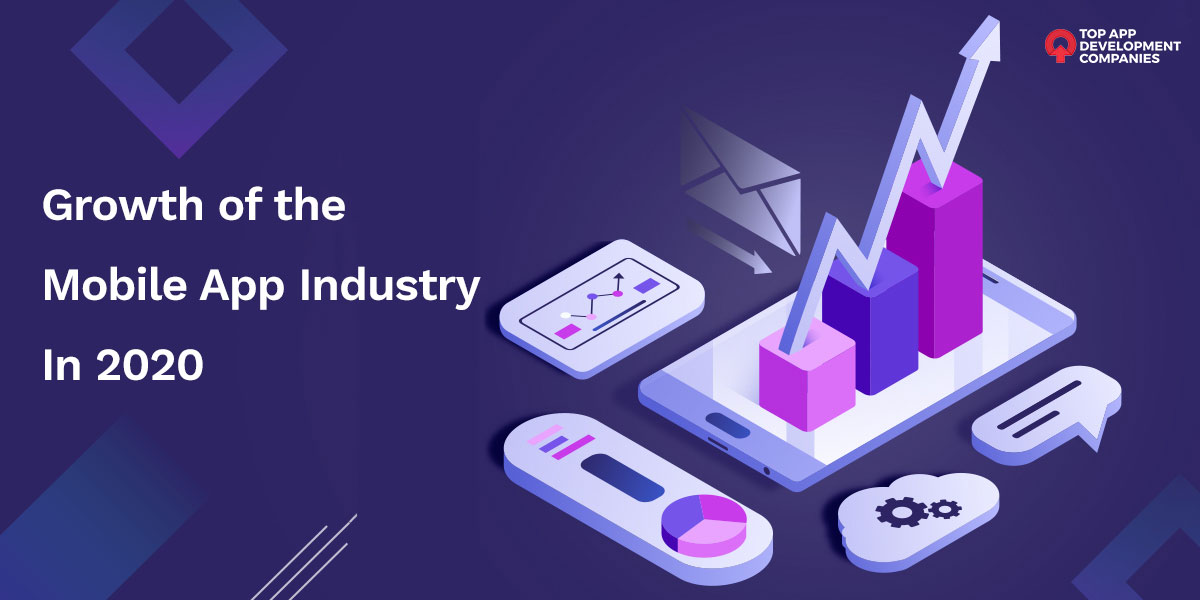
.jpg)
.jpg)
.jpg)
.jpg)
.jpg)
.jpg)
.jpg)
.jpg)
.jpg)
.jpg)
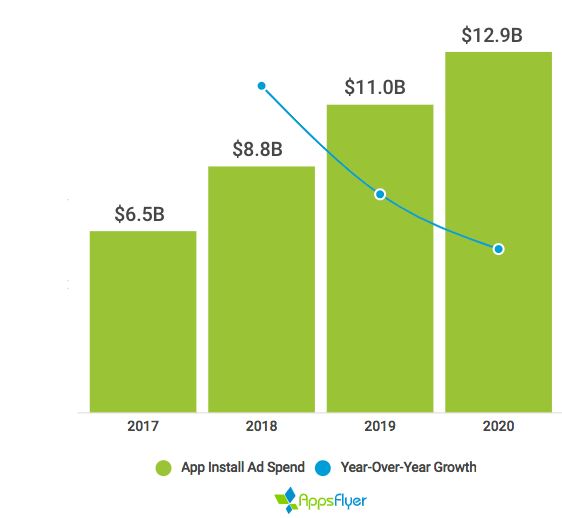
.jpg)
.jpg)
.jpg)
.jpg)
.jpg)
.jpg)
.jpg)
.jpg)
.jpg)
